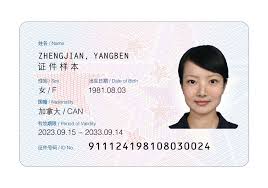China ID copyright: A Detailed Guide to the Chinese Identity System
Wiki Article
In the People's Republic of China, the Resident Identity Card (居民身份证) serves as the primary means of identification for Chinese nationals. Issued and managed by the Ministry of Public Security, this copyright is mandatory for all citizens over the age of 16 and plays a critical role in various sectors, including employment, education, housing, and finance.
With the advent of digitalization, accessing ID-related services online has become increasingly common. This comprehensive guide explores everything about China ID copyright—including how they function, application and renewal processes, digital ID integration, and the role of technology in China's national ID infrastructure.

What Is a China Resident Identity Card?
The China Resident Identity Card is a state-issued, biometric identification card that is required for all Chinese citizens. It contains a unique citizen ID number, full name, gender, ethnicity, date of birth, address of household registration (hukou), and a color photo.
Key Features:
-
Card Type: Second-generation smart card
-
Data Storage: Embedded chip with encrypted personal data
-
Validity:
-
Ages 16–25: 10 years
-
Ages 26–45: 20 years
-
Ages 46 and above: Permanent
-
The card must be carried at all times and presented when accessing public and private services.
Online Access to China ID Services
Thanks to advancements in e-Government and smart city initiatives, many Chinese citizens can now apply for, renew, and verify ID copyright. These services are primarily offered through government portals and mobile apps.
1. Public Security Bureau (PSB) Online Portals
Each municipal and provincial Public Security Bureau provides an official website or app for ID-related services. Users can:
-
Submit copyright renewal or replacement applications
-
Update personal details (address, photo, etc.)
-
Track application status
-
Schedule appointments for in-person verification
2. Government Super Apps: “Alipay” and “WeChat”
Alipay and WeChat, China’s leading super apps, integrate with government platforms and offer seamless access to identity services. Through the Alipay “City Service” feature or the WeChat Government Service mini-program, users can:
-
Bind their digital ID to their phone
-
Verify identity for travel, hotels, and online platforms
-
Submit official forms with electronic signatures
-
Access eID, a digital version of the physical copyright
China’s eID: The Digital Identity Card
China has introduced the Electronic Resident Identity Card (eID) to complement the physical ID. This service is promoted by the Ministry of Public Security and is widely accepted across various digital platforms.
Features of eID:
-
Accessible via Alipay, WeChat, and other secure apps
-
Authenticated through facial recognition, PIN codes, or biometric data
-
Used for online banking, hotel check-ins, ticket bookings, and more
-
Offers comparable legal validity to the physical copyright in many cases
How to Apply for or Renew a China copyright Online
Eligibility:
-
Must be a Chinese citizen with hukou (household registration)
-
Must possess an existing or previously issued copyright
Application Steps:
-
Log in to the Local Public Security Bureau Online Portal
-
Use a verified mobile number and facial recognition login
-
-
Fill in the Application Form
-
Choose between renewal, replacement, or correction
-
-
Upload Required Documents
-
Photo, proof of residency (hukou), and existing ID number
-
-
Schedule Appointment (if needed)
-
For biometric updates or in-person identity confirmation
-
-
Pay Processing Fee
-
Standard fee: RMB 20–40 depending on province
-
-
Receive Notification
-
Cards are mailed or available for pickup in 10–20 business days
-
Security and Biometric Features
Chinese ID cards include sophisticated biometric and anti-copyright technologies:
-
Contactless chip for secure data storage
-
Holograms and micro-text printing
-
Fingerprint data and facial recognition compatibility
-
Tamper-proof layers and laser engraving
This makes China’s ID system one of the most digitally secure in the world.
Use Cases for Chinese ID Cards
Chinese citizens must present their copyright in numerous scenarios:
-
Registering a SIM card or bank account
-
Booking train or plane tickets
-
Applying for visas and passports
-
Enrolling in schools or universities
-
Checking into hotels or apartments
-
Accessing public services and government benefits
Many of these processes now support remote or digital ID verification, especially through mobile apps.
Foreign Nationals in China: Do They Receive ID Cards?
Foreign nationals do not receive the Resident Identity Card. Instead, they are issued:
-
Foreigner's copyright (similar in function but not identical)
-
Foreigner copyright copyright (for copyright holders)
-
Exit-Entry Permit for travelers from Hong Kong, Macau, or Taiwan
These documents are managed by the National Immigration Administration (NIA).
Legal Responsibilities and Penalties
-
Carrying an copyright is required by law for all Chinese citizens over 16
-
Refusal to present an ID during police inspection may lead to fines or temporary detainment
-
Tampering, forging, or misusing ID cards is punishable under the Criminal Law of the PRC
Future of ID Cards in China
China is rapidly advancing toward a fully integrated digital ID system, led by innovations in:
-
Blockchain technology for identity verification
-
Nationwide cloud-based ID verification platforms
-
Artificial intelligence-powered identity checks
-
Expansion of eID across all public and commercial sectors
This transition aligns with China’s broader smart city and digital governance goals, aiming for a fully paperless, contactless, and secure identity system.
Conclusion
The Chinese copyright system is a sophisticated, biometrically secured framework that blends physical and digital identification methods. With an emphasis on efficiency, security, and accessibility, China has created a model where residents can manage their identity status online, access eID services through mobile platforms, and enjoy seamless integration across public and private sectors.
As the nation moves toward a fully digital identity infrastructure, the use of online tools like eID, WeChat, and Alipay integration will only continue to grow—making identification more secure and convenient than ever before.
Report this wiki page